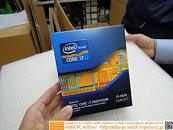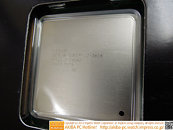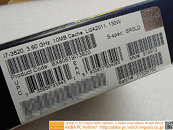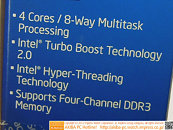Monday, February 13th 2012

Core i7-3820 Sandy Bridge-E Starts Selling in Japan
Intel's most affordable processor in the LGA2011 package, the Core i7-3820, surfaced on Japanese stores in the Akihabara electronics shopping district of Tokyo. It is priced around 25,000 JPY (US $322). The retail box of this chip, carrying the S-Spec code "SR0LD", appears to be as big as those of the Core i7-3930K and Core i7-3960X Extreme Edition, its shape indicates that it lacks a bundled cooling solution, and so users should still rely on compatible third-party coolers, or use Intel's RTS2011LC, purchased separately.
The Core i7-3820 is a quad-core part carved out of the Sandy Bridge-E silicon. It has four cores, and eight logical CPUs enabled with HyperThreading Technology. The chip is clocked at 3.60 GHz. Caches include 256 KB L2 per core, and 10 MB shared L3. The chip retains the quad-channel DDR3 IMC present on the more expensive six-core parts. It is also said to be "limited unlocked", meaning it allows multiplier-assisted overclocking to a certain limit. The Core i7-3820 is not officially launched, though it should be unofficially supported by most socket LGA2011 motherboards based on the X79 chipset.
Source:
PCWatch Akiba
The Core i7-3820 is a quad-core part carved out of the Sandy Bridge-E silicon. It has four cores, and eight logical CPUs enabled with HyperThreading Technology. The chip is clocked at 3.60 GHz. Caches include 256 KB L2 per core, and 10 MB shared L3. The chip retains the quad-channel DDR3 IMC present on the more expensive six-core parts. It is also said to be "limited unlocked", meaning it allows multiplier-assisted overclocking to a certain limit. The Core i7-3820 is not officially launched, though it should be unofficially supported by most socket LGA2011 motherboards based on the X79 chipset.




32 Comments on Core i7-3820 Sandy Bridge-E Starts Selling in Japan
www.scan.co.uk/products/intel-core-i7-3820-s-2011-sandy-bridge-e-quad-core-36ghz-10mb-cache-130w-retail?utm_source=google+shopping&utm_medium=google+shopping
Not that that will stop me from getting one.:laugh:
It would seem to me that you should choose the board that you're happy with, between SB-E and SB and if you don't feel you're paying over the odds for a SB-E board then the 3820 is the one to go for.
Having said that I think in the vast majority of cases the 2700K wins it.
Why? Because the features on motherboards now, in my opinion, are not worth it.
Extra PCI-E lanes are only useful for the minority that run multiple graphics cards, and even then the extra lanes don't deliver cost effective performance - although if you're going for high end then you're already happy to sacrifice bang for buck.
The build in sound I've never found to be as good as a proper discrete card. Which makes me say who is going to drop hundreds on a motherboard (and likely change it in 2-3 years tops) but not prepared to drop money on a decent sound card?
USB slots... needed? Really? Isn't a couple of USB 3 ports enough? The USB 2 ports can be expanded with dirt cheap hubs.
Overclocking? First of all the higher end boards provide more stable power, usually, but other than that there's not a great deal of difference, you're going to maybe get 100 mhz more, or 200 tops... is that worth dropping an extra couple of hundred on? And it seems that board designers across the market have one basic design and they add/remove built in features to it, that would seem to indicate that overclocking performance isn't going to be greatly different across the ranges.
Memory advantages? Really? Anyone who's looked into it knows that with a discrete graphics card memory speeds don't make much of a difference at all... certainly it's the worst area to spend extra money on a build.
So.. if you can justify a SB-E motherboard then go for it.. but I seem to be seeing right through the high end motherboards so I think the 2700K is the right one for now.
Personally I'm holding off to Ivy Bridge and I'll possibly grab the top end CPU there and a dirt cheap cougar point board to pair it up with. I now suspect I'll have no regrets.
Intel is obviously looking to make more money by having their top dog change as fast as possible. I'm not counting the hexacores because of their price of course
Perhaps the SB-E will have more longevity for productivity type stuff - rendering etc. But for general purpose use you could justify the X58 platform in a pinch, but if the -E is beaten by the next release of the standard platform then the -E is going to only go where money is of little object.